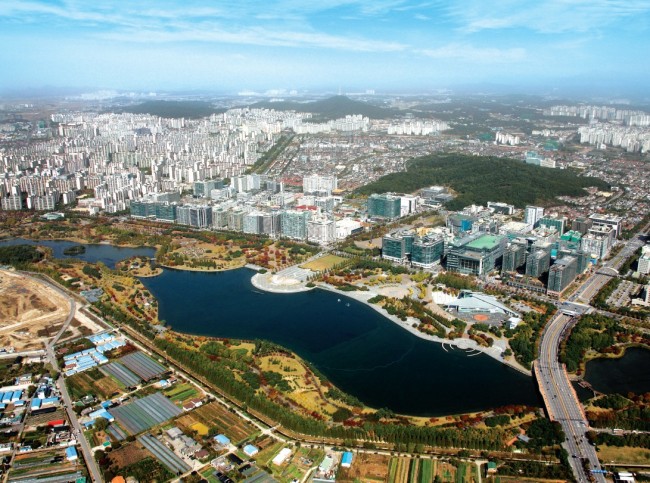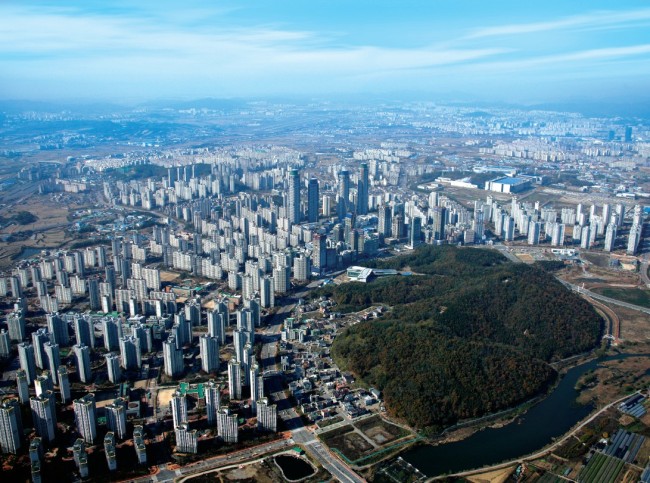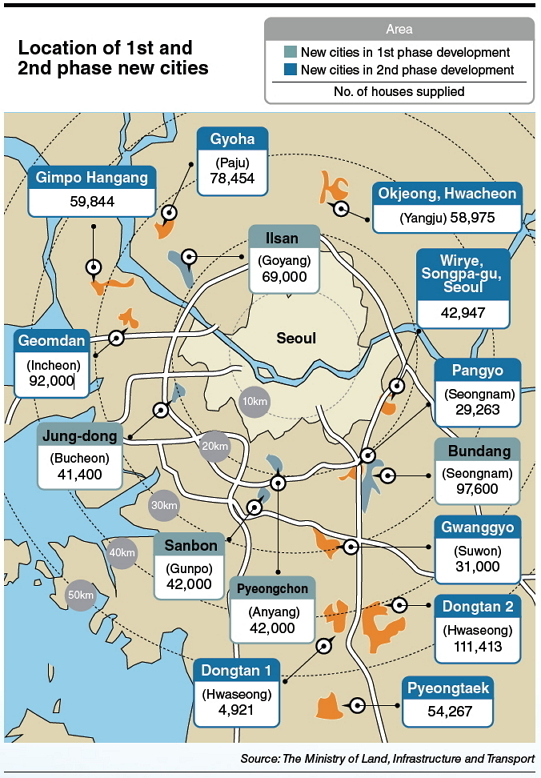[Power Korea] New city development scheme spurs urbanization, concentration in capital area
With urbanization accelerating, Korea has adopted and advanced the ‘new city’ development policy to supply houses and develop land
By Seo Jee-yeonPublished : July 15, 2013 - 20:14
For the past six decades, Korea has experienced rapid industrialization, and with it, rapid urban growth. As the nation’s core industries quickly evolved from the primary sectors to manufacturing and services between the 1960s and 1990s, the urban population grew rapidly.
Ninety-one percent of the population lived in cities in 2010, compared to 50 percent in 1970, according to Hyundai Research Institute.
In the course of urbanization, population and income per capita have grown as well, spurring the housing demand. The population of Korea in 2012 stood at about 50 million and per capita gross domestic product reached about $23,600 in the same year.
In the early stages of economic development, the government developed a localized housing supply strategy, nicknamed the “new city” development policy, to deal with the rising demand for urban housing despite limited available land.
‘Industrial new city’ development (1960s-1970s)
In the 1960s, the government developed Ulsan (1962) and Pohang (1968) as two new major industrial cities for employees who worked in the industrial complexes there.
In the 1970s, based on the announcement of the government’s heavy and chemical industry development, the government constructed industrial cities in Gumi (1973), Changwon (1977) and Yeocheon (1977) to promote the heavy and chemical industries and to expand exports.
Near Seoul, Gwacheon in Gyeonggi Province was developed in 1979 to house key government offices previously situated in Seoul.
First-phase new city development in capital region (1980s)
In the 1980s, the rise in housing demand was accommodated by developing rural areas into new towns. However, despite government efforts to seek regional balance, housing prices escalated due to the growing urban population, lack of housing and real estate speculation.
In order to cope with the rising housing demand, the government developed vacant areas, depleting most easily developed green field sites by the end of the 1980s.
In 1988, the government established a large-scale, five-year housing plan with the specific goal of supplying 2 million housing units. The government unveiled the first phase of the new city development plan, which was aimed to develop five new cities in the area around Seoul ― Bundang, Ilsan, Jungdong, Sanbon and Pyeongchon.
Ninety-one percent of the population lived in cities in 2010, compared to 50 percent in 1970, according to Hyundai Research Institute.
In the course of urbanization, population and income per capita have grown as well, spurring the housing demand. The population of Korea in 2012 stood at about 50 million and per capita gross domestic product reached about $23,600 in the same year.
In the early stages of economic development, the government developed a localized housing supply strategy, nicknamed the “new city” development policy, to deal with the rising demand for urban housing despite limited available land.
‘Industrial new city’ development (1960s-1970s)
In the 1960s, the government developed Ulsan (1962) and Pohang (1968) as two new major industrial cities for employees who worked in the industrial complexes there.
In the 1970s, based on the announcement of the government’s heavy and chemical industry development, the government constructed industrial cities in Gumi (1973), Changwon (1977) and Yeocheon (1977) to promote the heavy and chemical industries and to expand exports.
Near Seoul, Gwacheon in Gyeonggi Province was developed in 1979 to house key government offices previously situated in Seoul.
First-phase new city development in capital region (1980s)
In the 1980s, the rise in housing demand was accommodated by developing rural areas into new towns. However, despite government efforts to seek regional balance, housing prices escalated due to the growing urban population, lack of housing and real estate speculation.
In order to cope with the rising housing demand, the government developed vacant areas, depleting most easily developed green field sites by the end of the 1980s.
In 1988, the government established a large-scale, five-year housing plan with the specific goal of supplying 2 million housing units. The government unveiled the first phase of the new city development plan, which was aimed to develop five new cities in the area around Seoul ― Bundang, Ilsan, Jungdong, Sanbon and Pyeongchon.

Bundang in Seongnam City, Gyeonggi Province, was a leading example of this first phase. It is located about 25 kilometers southeast of Seoul and is less than 10 km from the Gangnam area, a business and commercial district in the southern part of Seoul.
Bundang was designed to accommodate 390,000 people. The purpose of this new town was to absorb the increasing population of Gangnam and build a self-sufficient suburban community for the middle class.
Second-phase residential new towns development (1990s-2000s)
The building of new homes stabilized the housing market by the mid-1990s. Additional large-scale, new residential developments were not developed in the late 1990s. Instead, small urban developments were carried out by local governments.
As housing prices began rising again in the 2000s, the second-phase new cities including Pangyo, Dongtan, Unjeong and Gimpo, were developed in the capital area.

The construction period for the plan is from 2000 to 2015 and 1.53 million people are expected to be accommodated after completion.
The new towns in the 2000s, in particular, are designed to be environmentally friendly and self-sustaining.
For instance, Dongtan in Hwaseong City, Gyeonggi Province, is developing as a high-tech-driven green city. About 93 hectares of land is planned for venture companies and research facilities, but industrial sites will be eco-friendly.
Diversification of new cities
Beyond the second-phase new towns, which were driven by the housing supply policy, several new cities for special purposes were developed after the 2000s. Business-friendly city development linked to free economic zones such as Songdo appeared.
Under the purpose of balanced land development, the government is developing innovation cities nationwide where public organizations, including state-run companies, will be relocated.

Sejong City was created to relocate ministries and other government bodies to decentralize central administrative functions.
The enterprise city development project is also underway. The project was proposed in 2004 by the Federation of Korean Industries in 2003 to encourage company investment and create jobs.
Impact of new city development policy
The large-scale development of new cities has had several effects on the economy. On one hand, as a large amount of housing was supplied, housing prices have stabilized. The city development also created jobs, while supporting industrialization.
Despite these benefits, there were also many problems blamed on the development of the new cities in such a short period of time. For instance, some urban planning critics said that creating five new cities in the first phase accelerated the population concentration in the Seoul area and hindered balanced national development.
And while the new towns provided houses for workers in Seoul, those workers also hade to commute further, while housing and land prices rose in the new town areas.
Additionally, the large-scale projects led to shortages of construction material and manpower, increased prices, and caused environmental destruction.
To solve these problems, the government allowed the development of smaller, more dispersed residential areas and the development of semi-agricultural land.
By Seo Jee-yeon (jyseo@heraldcorp.com)












![[Today’s K-pop] BTS pop-up event to come to Seoul](http://res.heraldm.com/phpwas/restmb_idxmake.php?idx=644&simg=/content/image/2024/04/17/20240417050734_0.jpg&u=)




![[KH Explains] Hyundai's full hybrid edge to pay off amid slow transition to pure EVs](http://res.heraldm.com/phpwas/restmb_idxmake.php?idx=652&simg=/content/image/2024/04/18/20240418050645_0.jpg&u=20240419100350)

